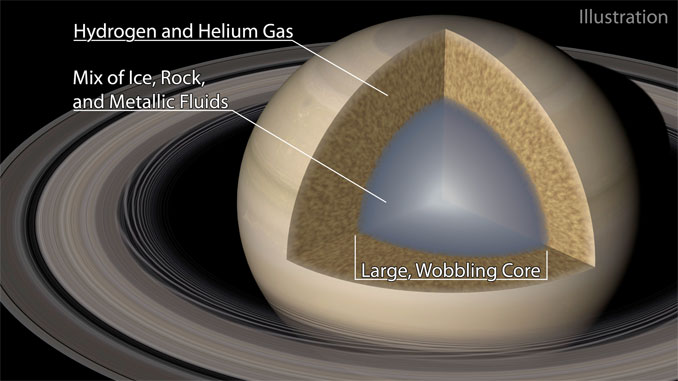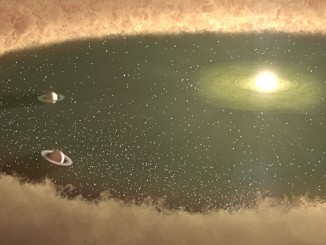
Subtle ripples in Saturn’s innermost rings indicate the planet’s core is not a compact, solid structure as some have theorised but more like a thick “soup” of ice, rock and metallic fluids extending across 60 percent of the planet’s diameter.
The sludge-like “fuzzy” core sloshes about ever so slightly as the planet rotates, causing fluctuations in Saturn’s gravitational field that set up tell-tale spiral patterns in its innermost rings.
“We used Saturn’s rings like a giant seismograph to measure oscillations inside the planet,” said Jim Fuller, assistant professor of theoretical astrophysics at Caltech and co-author of a paper in Nature Astronomy. “This is the first time we’ve been able to seismically probe the structure of a gas giant planet, and the results were pretty surprising.”
The findings, based on data collected by NASA’s Cassini spacecraft, are the best evidence yet of a fuzzy core and are in step with recent observations by NASA’s Juno probe of a similar “diluted” core below Jupiter’s cloudtops.
Lead author Christopher Mankovich, a postdoctoral scholar research associate in planetary science, said fuzzy cores “are like a sludge.”
“The hydrogen and helium gas in the planet gradually mix with more and more ice and rock as you move toward the planet’s centre,” he said. “It’s a bit like parts of Earth’s oceans where the saltiness increases as you get to deeper and deeper levels, creating a stable configuration.”
He said Saturn is “always quaking, but it’s subtle.”
“The planet’s surface moves about a metre every one to two hours like a slowly rippling lake,” Mankovich said. “Like a seismograph, the rings pick up the gravity disturbances, and the ring particles start to wiggle around.”
The research indicates Saturn’s core is 55 times more massive than Earth. The observed ripples indicate that while the deep interior of Saturn is sloshing back and forth, it’s composed of stable layers made up of heavier materials that sank toward the centre of the core and stopped mixing with lighter components above them.
For Saturn’s gravitational field to be oscillating at the observed frequencies, “the interior must be stable,” Fuller said, “and that’s only possible if the fraction of ice and rock gradually increases as you go in toward the planet’s centre.”
Gas giant formation has long been thought to begin with rocky cores that then attract huge gas envelopes. If fuzzy cores are common, gas likely is incorporated at an earlier stage in the formation process.



